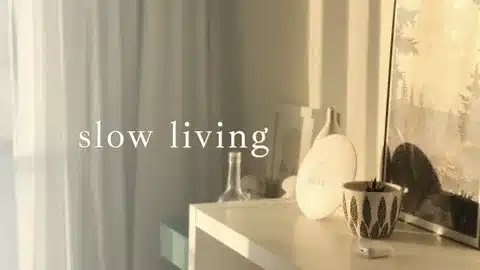Slow Living
Have you ever felt like life is happening to you rather than with you? Like the days blur into each other in a relentless race of deadlines, notifications, and to-do lists that never end? You’re not alone.
In our hyper-connected, hustle-obsessed world, more and more people are quietly questioning the pace of their lives, and many of them are discovering that the answer is not doing more; it’s doing less. But doing it better. Doing it intentionally. Doing it slowly.
Welcome to the world of slow living—a lifestyle choice that’s more than a hashtag or fleeting trend. It’s a return to what matters. A rebellion against the tyranny of speed. A reconnection to our values, our communities, our environment, and most importantly, ourselves.
In this post, we’ll dive into the deep roots of the slow living philosophy, explore why it’s becoming the next big lifestyle shift, and walk step-by-step into how you can invite more slowness into your life without feeling like you’re missing out or falling behind.
Let’s slow down together.

What Is the Ideology of Slow Living?
Slow living isn’t just about moving at a snail’s pace or romanticising countryside life (though if that’s your thing, more power to you). At its core, slow living is an ideology of intentionality. It’s about consciously choosing how you spend your time, energy, and attention.
It’s the belief that faster doesn’t always mean better and that in slowing down, we can actually live more fully, more deeply, and more meaningfully.
The roots of this philosophy go back to movements like the Slow Food Movement in Italy, which began as a reaction to the spread of fast food and the erosion of local culinary traditions. From there, it expanded into a broader lifestyle ethos that touches everything from work to parenting, fashion to travel.
Slow living asks questions like:
- What am I rushing toward?
- What truly fills me up?
- Am I living in alignment with my values, or am I caught up in society’s conveyor belt?
It’s not about rejecting ambition or comfort—it’s about redefining success on your own terms. At the heart of it? Presence. Simplicity. Purpose. Connection.
Why Is Slow Living the Next Big Lifestyle Trend?
Let’s be real: modern life is exhausting.
We’re plugged in 24/7, expected to be available at all times, to answer emails at midnight, and to keep up with the news cycle, trends, algorithms, and oh, don’t forget self-care (which itself has been hijacked into another item on the checklist).
Some might say slow living is a response to the pandemic, but the truth is, this movement has been bubbling under the surface for decades. The pandemic simply turned the volume up on a message people were already starting to whisper: This pace of life is unsustainable.
And that’s where slow living enters as the antidote to hustle culture.
Why is it gaining ground?
- Digital Fatigue: We’re drowning in information but starved for meaning. People are yearning for real, offline experiences that fill the soul, not the feed. Slow living beautifully overlaps with the minimalist and digital detox trends. People are yearning to disconnect from the noise and reconnect with themselves, others, and the earth.
- Burnout Epidemic: WHO officially recognised burnout as an occupational syndrome. People are overworked, overstimulated, and undernourished emotionally. We are seeing record levels of burnout, not just in careers but in parenting, socialising, and even self-care. People are tired of running on empty.
- Minimalism & Sustainability Movements: Consumers are becoming more conscious of the environmental and emotional cost of their lifestyles. From fashion to food to travel, more people are embracing slower, eco-friendlier habits.
- Mindfulness Awareness: Mindfulness is now mainstream, opening doors for slow living to become an extension of that—taking mindfulness off the mat and into everyday life.
- Gen Z’s Rejection of Hustle Culture: Unlike Millennials, many Gen Zers are already sceptical of the 24/7 grind. They’re pioneering “quiet quitting” and valuing work-life balance as a non-negotiable. Wealth is now being redefined as time freedom, peace of mind, and quality of relationships.
In short? Slow living is the next big thing because it’s the only sustainable thing.
How Do I Start Slow Living?
Starting slow living doesn’t mean you quit your job, move to a cabin, and churn your own butter (unless you want to, of course). It’s about small, mindful shifts that fit your current reality.
Here’s how to begin:
- Audit Your Life Pace:
Where are you constantly rushing? Is it mornings, work tasks, or weekends packed to the brim? Where does your calendar feel suffocating? Get honest. Identify your personal speed traps. - Create ‘Margin’ in Your Days:
Schedule blank space. Yes, actually schedule it. Space to breathe, reflect, and be. Even 10 minutes of undistracted, slow time can work wonders - Start Single-Tasking:
Ban multitasking. When eating, eat. When walking, walk. When working, work. Engage fully in each experience. - Prioritise Essentials:
Start noticing how often you say “yes” to things out of habit or guilt. Practice saying “no” gracefully. Get brutally clear on what matters to you. If it’s not a ‘hell yes,’ it’s a ‘no.’ - Slow Your Consumption:
Eat slowly. Shop slowly. Even consume content slowly—read long-form articles; sit with them. - Introduce Mindful Rituals:
Incorporate practices like mindful breathing, meditation, or simply watching the sunset without checking your phone. Tea ceremonies, mindful walks, journaling—anchor your days with slowness.
Remember, it’s not about perfection—it’s about practice.

What Are the Habits of Slow Living?
Slow living isn’t a destination; it’s a rhythm. Here are the daily, weekly, and seasonal habits that embody it:
- Daily:
Morning pages, mindful meals, device-free evenings, gratitude practices. - Weekly:
Slow Sundays, analog hobbies (gardening, painting), deep conversations. - Seasonally:
Celebrating nature’s rhythms, resting more in winter, embracing fresh starts in spring.
These habits are less about rules and more about creating intentional patterns that ground you in the present.
What Are the Qualities of Slow Living?
You can spot a slow living practitioner not by their outfit but by their vibe. Beyond habits, slow living cultivates certain inner qualities:
They exude:
- Presence: They give you their full attention.
- Contentment: They radiate ‘enoughness’ instead of scarcity.
- Gratitude: They delight in small joys—a cup of tea, birdsong, a handwritten note.
- Simplicity: They declutter their schedule and their space.
- Resilience: They bounce back with grace because they’re not running on empty.
- Intentionality: Choosing with clarity.
In essence, they live deliberately, not reactively.
How Do You Promote Slow Living?
Whether you’re a parent, a creator, or a community leader, you can advocate for slow living by:
- Modeling It: Be the change. Show people it’s possible.
- Sharing Your Story: Talk about how slowing down has changed your life.
- Creating Slow Spaces: Start book clubs, potlucks, or unplugged retreats.
- Challenging Hustle Narratives: Call out toxic productivity myths gently but firmly.
- Inspiring Through Art, Writing, and Social Media: Use your platforms to spread the slow message.
How to Embrace Slow Life Without Boredom?
Ah, the fear of boredom—a common myth about slow living.
Slow living doesn’t equal a boring life. It actually invites depth into your days.
When you first slow down, you might confront an eerie stillness. That’s your nervous system recalibrating.
But over time, you’ll notice something magical: you’re not bored; you’re free.
Here’s how to make the transition smoother:
Rediscover forgotten hobbies: Painting, gardening, letter writing.
Engage your senses: Cook with fresh herbs, listen to birds, feel textures.
Learn to be without doing: Sit in silence, observe nature, journal your thoughts.
Practice creativity for joy, not results: Dance, doodle, write poetry.
Seek community in slowness: Attend slow dinners, book clubs, art workshops.
The truth is, boredom often masks disconnection from self. When you slow down, you reconnect—and that’s anything but boring.
Is Slow Living Worth It?
Slow living might not bring instant dopamine hits or flashy Instagram moments. But what it does bring is something deeper, quieter, and arguably richer and yes, it’s absolutely worth it.
You gain:
- Better mental health
- Deeper relationships
- A richer inner life
- Aligned actions over scattered effort
- A sense of sufficiency and joy that no amount of hustle can buy
In slowing down, you don’t miss out on life; you meet it more fully.
The World Is Fast Enough—You Don’t Have to Be
Slow living isn’t about opting out of modern life. It’s about engaging with it on your own terms. It’s about showing up for your life—not as an exhausted bystander, but as an active, joyful participant. It’s about creating space to feel, think, connect, and breathe.
In a world screaming faster, louder, and more, slow living whispers, softer, gentler, enough.
You don’t need to wait for burnout to start living slower. Start now, with the smallest step. Watch the sunset. Eat dinner without your phone
So, let’s redefine success together—not by how fast we move, but by how fully we live.
Your journey into slow living doesn’t start next month, next year, or when the stars align. It starts with your next breath.
Breathe in. Breathe out. Begin now.
Stay frosty!
Explore more on Slow Living




